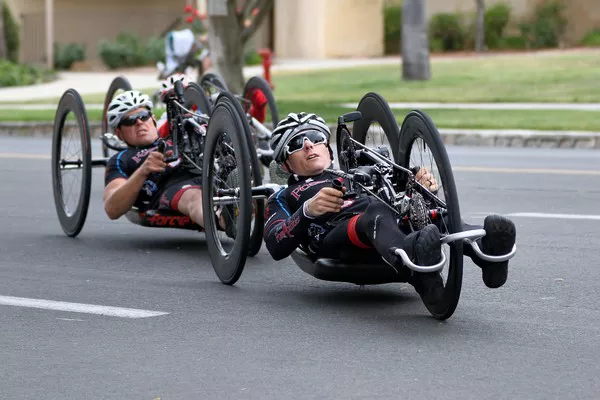Para cycling stands at the intersection of athleticism, determination, and inclusivity, offering a platform for athletes with disabilities to excel in the realm of competitive cycling. As a discipline within the broader spectrum of para sports, para cycling has gained significant traction and recognition for its ability to showcase the remarkable capabilities of individuals overcoming physical challenges. From its humble beginnings to its current status as a globally recognized sport, para cycling exemplifies the triumph of the human spirit and the power of sport to transcend barriers.
Understanding Para Cycling: A Multifaceted Discipline
Para cycling encompasses various categories, each tailored to accommodate athletes with different types and degrees of disabilities. The classification system, developed and regulated by the Union Cycliste Internationale (UCI), ensures fair competition by grouping athletes based on their functional abilities. This classification system takes into account factors such as muscle strength, coordination, and balance, providing a level playing field for participants with diverse impairments.
The categories in para cycling include hand cycling, tandem cycling, and tricycle cycling, among others. Hand cycling involves athletes using hand-operated cycles, typically recumbent in design, where they pedal using their arms instead of their legs. Tandem cycling pairs visually impaired or blind athletes with sighted pilots who guide the bike while the visually impaired athlete contributes to pedaling power. Tricycle cycling caters to athletes with balance impairments who require the stability provided by a three-wheeled cycle.
Within each category, athletes compete in road races, time trials, and track events, showcasing their speed, endurance, and tactical prowess. The diversity of events and categories within para cycling ensures that there is a suitable platform for athletes with various disabilities to participate and excel.
The Evolution of Para Cycling: From Rehabilitation to Elite Sport
The origins of para cycling can be traced back to the mid-20th century when cycling was recognized as a beneficial form of rehabilitation for individuals with disabilities, particularly those who had suffered spinal cord injuries or limb amputations. Cycling offered not only physical therapy but also a sense of freedom and independence for individuals adjusting to life with a disability.
Over time, as the benefits of cycling became increasingly apparent, organized para cycling events began to emerge, providing opportunities for athletes to compete at local and national levels. These grassroots initiatives laid the foundation for the development of para cycling as a legitimate sport, leading to its inclusion in prestigious international competitions such as the Paralympic Games and the UCI Para Cycling World Championships.
The recognition of para cycling as a Paralympic sport in 1988 marked a significant milestone in its evolution, catapulting it onto the global stage and attracting greater attention and investment. Since then, para cycling has continued to grow in popularity, with participation levels rising and standards of competition reaching new heights.
Challenges and Triumphs: Navigating the Path to Success
Despite its remarkable progress, para cycling still faces numerous challenges, both logistical and societal, that can hinder the full realization of its potential. Access to specialized equipment, training facilities, and coaching expertise remains a significant hurdle for many athletes, particularly those from underprivileged backgrounds or regions with limited resources.
Moreover, para cycling, like many other para sports, contends with stereotypes and misconceptions surrounding disability, often leading to misconceptions about the capabilities of athletes with disabilities. Breaking down these barriers requires not only increased visibility and representation but also a shift in societal attitudes towards disability and athleticism.
However, amidst these challenges, para cycling continues to inspire and uplift, showcasing the extraordinary achievements of athletes who refuse to be defined by their disabilities. The stories of para cyclists overcoming adversity, pushing boundaries, and achieving sporting excellence serve as a testament to the resilience of the human spirit and the transformative power of sport.
The Road Ahead: Promoting Inclusivity and Growth
As para cycling enters a new era of development and expansion, there is a growing emphasis on promoting inclusivity, diversity, and accessibility within the sport. Initiatives aimed at increasing participation among marginalized communities, improving access to resources and facilities, and raising awareness about para cycling are essential steps towards creating a more inclusive and equitable sporting landscape.
Furthermore, collaboration between stakeholders, including sports governing bodies, government agencies, corporate sponsors, and advocacy organizations, is crucial for driving sustainable growth and development within the para cycling community. By working together to address barriers and create opportunities, we can ensure that para cycling continues to thrive and inspire future generations of athletes.
Conclusion
In conclusion, para cycling represents far more than just a sport; it is a symbol of resilience, determination, and the limitless potential of the human spirit. By providing a platform for athletes with disabilities to showcase their abilities and compete at the highest level, para cycling embodies the true spirit of inclusivity and empowerment. As we continue to champion the cause of para cycling and support the athletes who embody its values, we move closer towards a world where sport truly knows no limits.

